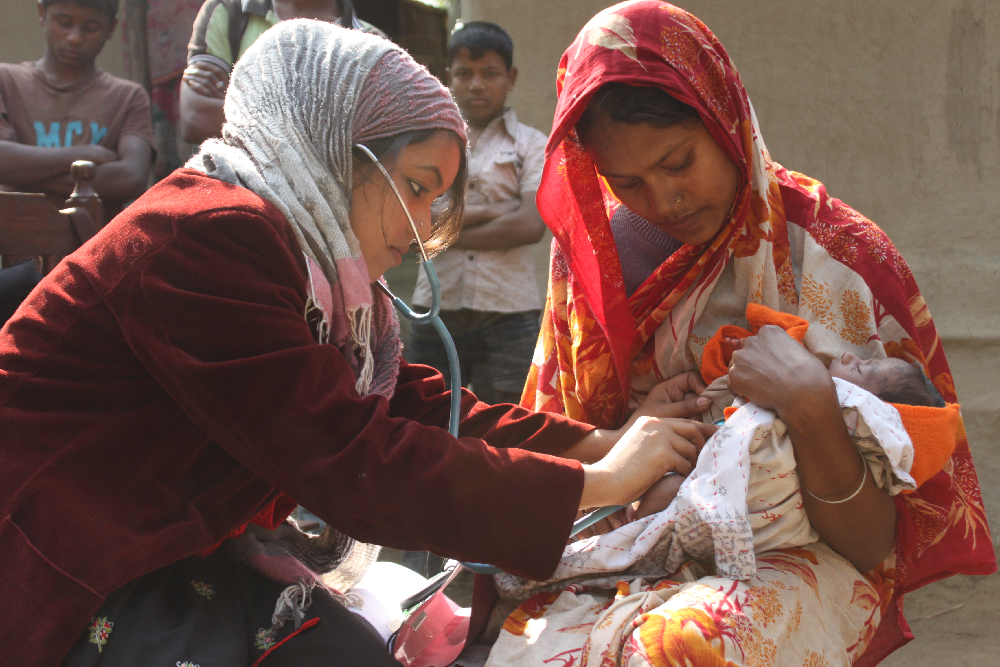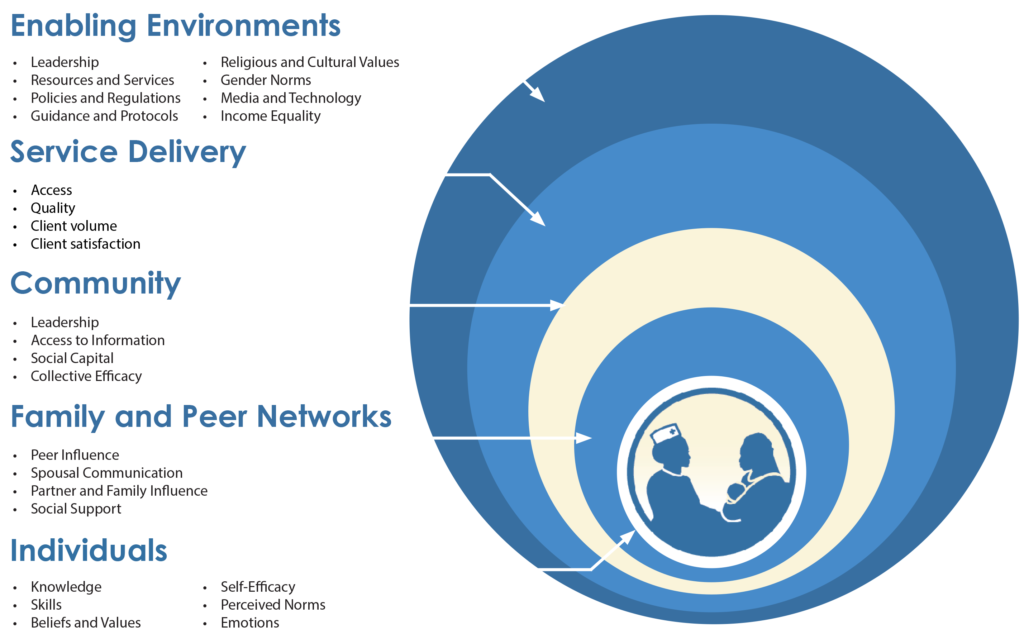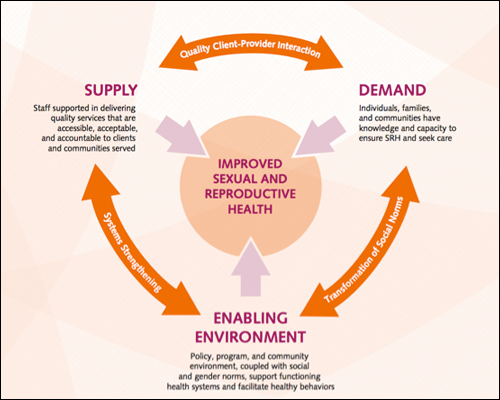This section provides an introduction to service communication. Take time to review the key principles and rationale for service communication, as this information will be referred to throughout this I-Kit:
- What is SBCC? Understand key SBCC concepts and terminology.
- What is Service Communication? Learn what Service Communication is, why it should be used and how it is best applied across the continuum of care.
- What evidence is there for Service Communication? Study the evidence for Service Communication and access additional research.
What is SBCC and Why is It Important to Service Delivery?
Social and Behavior Change Communication (SBCC) is the use of communication to change behaviors – including service utilization – and promote social change by positively influencing knowledge, attitudes and social norms.
SBCC goes beyond the delivery of a simple message or slogan to encompass the full range of ways in which people individually and collectively convey meaning. Among the powerful tools employed by SBCC programs are mass media, community-level activities, interpersonal communication, information and communication technologies and new media.
Effective SBCC is critical to improving behavior and health outcomes across the continuum of care. SBCC can be used to increase demand for and uptake of services, and improve consistent long-term maintenance of behaviors. SBCC plays a key role in each stage of healthcare service delivery – before, during and after. In the before stage, SBCC can help get clients to services by building individual and community support for health issues and related services, influencing norms and creating demand among intended clients. During service delivery, SBCC techniques can be used to enhance the client experience and ensure new behaviors are adopted by improving provider counseling and client support. After services, SBCC can support follow-up and behavioral maintenance by building and maintaining linkages between communities and service providers.
SBCC can also help ensure sustained demand and access to services through engaging community leaders and influencers in community mobilization and advocacy to shift underlying norms around service-seeking behavior.
Key Principles of SBCC
- SBCC is a process: SBCC is an entire process rather than a product. Communication products and materials such as posters, TV or radio spots, flipcharts or leaflets are just a small part of the SBCC process. Effective SBCC starts with research and analysis to understand the context and the intended audience. Then, strategies are developed to coordinate key messages across multiple channels (print, community-level, social media, interpersonal communication, radio, TV) to reach the intended audience.
- SBCC works at multiple levels: Achieving sustainable social and behavior change requires SBCC programs to work at multiple levels of the system – individual, family, community, service delivery, and enabling environment. SBCC recognizes that individual and social change does not happen in a vacuum, but is dependent on larger structural systems and norms.
- SBCC uses multiple channels: SBCC coordinates messages across a variety of communication channels to reach multiple levels of society. Behavior and social change is more likely through repeated and varied exposure to messages.
- SBCC is strategic: SBCC programs are grounded in theory and designed using evidence that helps programmers understand the situation, the audience, and existing programs.

What is Service Communication?
Service communication is the use of SBCC processes and techniques to motivate health service-related behaviors among intended audiences across the continuum of care – Before, During and After services. Service communication can be used with community and facility-based services across health areas to improve a range of behavioral outcomes; for example, creating demand among couples for HIV tests before they seek services, motivating women of reproductive age to initiate long-term family planning during clinical counseling, or encouraging caregivers to ensure their children continue a full dose of artemisinin-based combination therapies (ACTs) after a positive malaria test result.
Service communication can also be used to improve provider performance (provider behavior change communication) with clients during and after clinical service.
Service communication can use multiple channels, including community mobilization and outreach, interpersonal communication, local TV and radio, print materials, and social media. The most common channels are interpersonal, community, and print.
Service delivery implementers may design and implement their own communication activities, partner with an SBCC implementer, or both. However it is implemented, service communication is vital to achieving behavioral outcomes - increased demand, improved uptake, and consistent long-term maintenance—across the three stages of service delivery. See the Design section for guidance on designing your own communication activities. See the Operational Considerations section for guidance on effectively coordinating efforts with SBCC projects.
Service Communication Addresses Key Determinants
Programs must first identify and understand the most important determinants that make adopting services difficult or impossible before developing communication strategies and messages. These determinants may include knowledge, attitudes, social norms or a range of other “ideational factors.” More on Ideation.
The table below describes how service communication activities may address identified behavioral determinants and ultimately lead to improved service uptake and behavioral maintenance.
| SBCC Activities and Channels | Behavioral Determinants | Behavioral Outcome |
|---|---|---|
|
|
Improved service uptake and behavioral maintenance |
Importance of Service Communication Throughout the Three Stages of Service Delivery
Each service delivery stage presents unique and important opportunities for communication to increase demand and uptake and help the intended audiences maintain new behaviors. It is important to remember that SBCC not only engages the individual client and provider, but also works to influence other levels of society: the national/policy level, the community/health facility, and peers and family. Clients and providers are influenced by many factors at multiple levels: Individual, Interpersonal, Community and Facility, and National. Those levels of influence are summarized in the Socio-Ecological Framework:
Socio-Ecological Model:

The table below summarizes the roles service communication plays at each level of the Socio-Ecological Framework across the three stages of service delivery.
SBCC's Role in Service Delivery
| Before | During | After |
|---|---|---|
National/Policy Level
| National/Policy Level
| National/Policy Level
|
Community/Facility Level
| Community/Facility Level
| Community/Facility Level
|
Interpersonal/Peer Level
| Interpersonal/Peer Level
| Interpersonal/Peer Level
|
Individual
| Individual
| Individual
|
Throughout each stage, communication also helps do the following:
- Address social norms that affect demand, behavior initiation and post-service behavioral maintenance
- Influence perceptions, beliefs, and attitudes related to the health problem and the services and products that prevent or treat it
- Advocate for supportive policies and investment to improve service delivery programs and related SBCC activities
- Strengthen organizational relationships within and between health systems and services, such as between facility- and community-based services
EngenderHealth’s Supply-Enabling Environment-Demand (SEED) Programming Model™ provides one example of how programs can be designed to address behavioral determinants at multiple levels – structural, individual, community, and health systems.
The SEED Programming Model™ can help ensure that: services are available and of high quality, there is sufficient demand for services, supportive norms exist, and health and political systems support services. Read more about the SEED Model™ here.
What Are the Limitations of Service Communication?
Although SBCC plays an important role in improving service delivery and uptake, there are a number of barriers to behavior change that SBCC alone cannot address:
- Inadequate infrastructure or logistical supplies that may lower provider motivation, increase work load, and limit available services
- Insufficient supply of commodities, making high-quality service delivery difficult or impossible
- Client or consumer inability to pay for products and services, reinforcing beliefs that services are inaccessible and out of reach for intended clients
Improving behaviors limited by these barriers requires coordination with other interventions, including health system strengthening, finance reform, and commodities procurement. However, communication techniques can be used to help raise awareness among decision-makers and advocate for additional attention and resources to address these barriers.
What Is the Evidence Base for Service Communication?
SBCC program evaluations have demonstrated how SBCC contributes to improved health outcomes among populations seeking services, including reductions in HIV incidence and increasing contraceptive prevalence rate. It is not always possible, however, to attribute health impact entirely to an individual program or to SBCC alone. This is especially the case if the barriers to behavior change are tied to barriers that communication cannot address on its own (such as poor or restrictive policies, lack of services or limited commodities). As a result, many SBCC programs measure short-term, intermediate results, such as increased knowledge, decreased stigma, increased self-efficacy and increased intention to seek services.
There is a growing body of evidence from program evaluations that have demonstrated SBCC’s role, specifically with attempts to identify positive correlation between exposure to SBCC and reported changes in intermediate results across a range of health areas, including family planning, HIV prevention, malaria, and maternal and child health. The following are some successful examples of SBCC’s impact in improving access to health services.
Family Planning
A number of studies have shown that mass media and interpersonal interventions, coupled with service provision, have increased intention to use and demand for modern contraceptives, and raised contraceptive prevalence, contributing to lower fertility rates. More.
HIV Prevention
HIV prevention programs providing voluntary medical male circumcision (VMMC) have sought to coordinate demand creation and service delivery. Communication has increased awareness of services and addressed barriers linked to fear of pain, misinformation, and social norms. More.
Malaria
Service communication has helped improve malaria-related health outcomes. Malaria-related service communication has been used to:
- Increase demand for and use of insecticide-treated nets
- Change provider behavior related to diagnosis and treatment of malaria
- Improve adherence to ACTs
- Address myths and misconceptions about malaria
- Change norms around health-seeking behavior
For example, a facility-based cluster randomized trial in Tanzania found that a communication intervention was associated with improved prescriber adherence to rapid diagnostic test results, and reduced over-prescription of antimalarials to almost zero. More.
Child Health
Service communication has been used in the child health area to increase vaccination coverage, improve child nutrition through positive feeding practices, increase care-seeking for life threatening conditions, and improve use of life-saving treatments.
For example, an intensive radio campaign in Burkina Faso addressed key lifesaving family behaviors for child survival. The radio campaign had a high reach. Results from a cluster randomized trial showed that in intervention areas, care seeking for diarrhea and getting treatment for rapid/labored breathing improved more than in control areas. Read more.
For additional child health-related evidence on the impact of integrating SBCC and health services, see the following resources:
- Role of Social Support in Improving Infant Feeding Practices in Western Kenya: A Quasi-Experimental Study
- Behavior Change Interventions and Child Nutritional Status
- SBCC Evidence in Child Survival Programs - Journal of Health Communication
- Demand Generation for 13 Life Saving Commodities - A synthesis of the evidence
- Engaging Communities With a Simple Tool to Help Increase Immunization Coverage
- Evidence of Effective Approaches to Social and Behavior Change Communication for Preventing and Reducing Stunting and Anemia
- Lactation counseling increases exclusive breast-feeding rates in Ghana
- Effect of counseling on nutritional status during pregnancy


